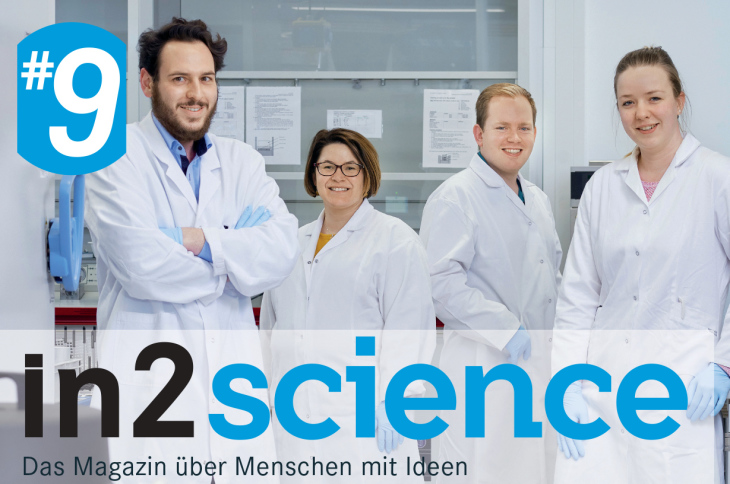| News
in2science #9 – New issue
Due to the coronavirus crisis, our magazine will initially only be published online. We will be sending out the printed version as soon as the situation has calmed down and we are back to normal.

Nils Holländer, Anke Schuster, Philipp Globig und Reneé Unbehau (from left to right) from the "Biological Characterisation" department are studying magnesium for implant medicine. [Photo: HZG/Christian Schmid]
Read about our HZG scientists, their fantastic ideas, and research projects in the ninth issue of our magazine.
- Magnesium for medicine The researchers from the HZG department of “Biological Characterisation” are working with a material that dissolves in the body all on its own: Magnesium. The metal is light and has great potential in implant medicine. We present their work in the in2science photo story.
- What moves us Prof. Matthias Rehahn and Silke Simon, our new management duo, chat to us about the new ideas they have for HZG. It is about challenges and opportunities, but also about weaknesses that both individuals identify for HZG.
- In talks / Infographic What exactly a water puzzle is and what extensive research activities lie behind it, is explained in the double interview and the infographic. DANUBIUS Research Infrastructure is the name of the large-scale project to research river–ocean systems.
- Portraits of the scientists of HZG We present portraits of scientists who strive to improve the air with coatings, and of an unconventional thinker with an adventurous spirit.
- News • There are several ongoing projects in which material researchers are investigating multifunctional surfaces. Surfaces, for example, that uses sunlight to convert chemical substances.
• The coastal researchers studied the current storm surge season and used the new online tool developed by HZG, the Sturmflut-Monitor.de, to do so.
• We introduce the HZG climate initiative, which several HZG climate researchers are involved in. The scientists are looking for solutions to avoid emissions, while the project also revolves around adapting to the consequences of climate change.
• Specific manufacturing techniques can be used to contribute to reducing CO2 emissions in industry. A new working group at the HZG Magnesium Innovation Center MagIC is working on this. - Statements You can read seven statements about what the HZG scientists are currently working on to achieve the goal of “zero CO2 emissions”.
We hope you enjoy reading this issue and look forward to your feedback!
Heidrun Hillen und Gesa Seidel
Contact persons
in2science editors
Phone: 04152/87 -1648 and 04152/87 -1784
E-mail contactPress and public relations
Helmholtz-Zentrum Geesthacht
